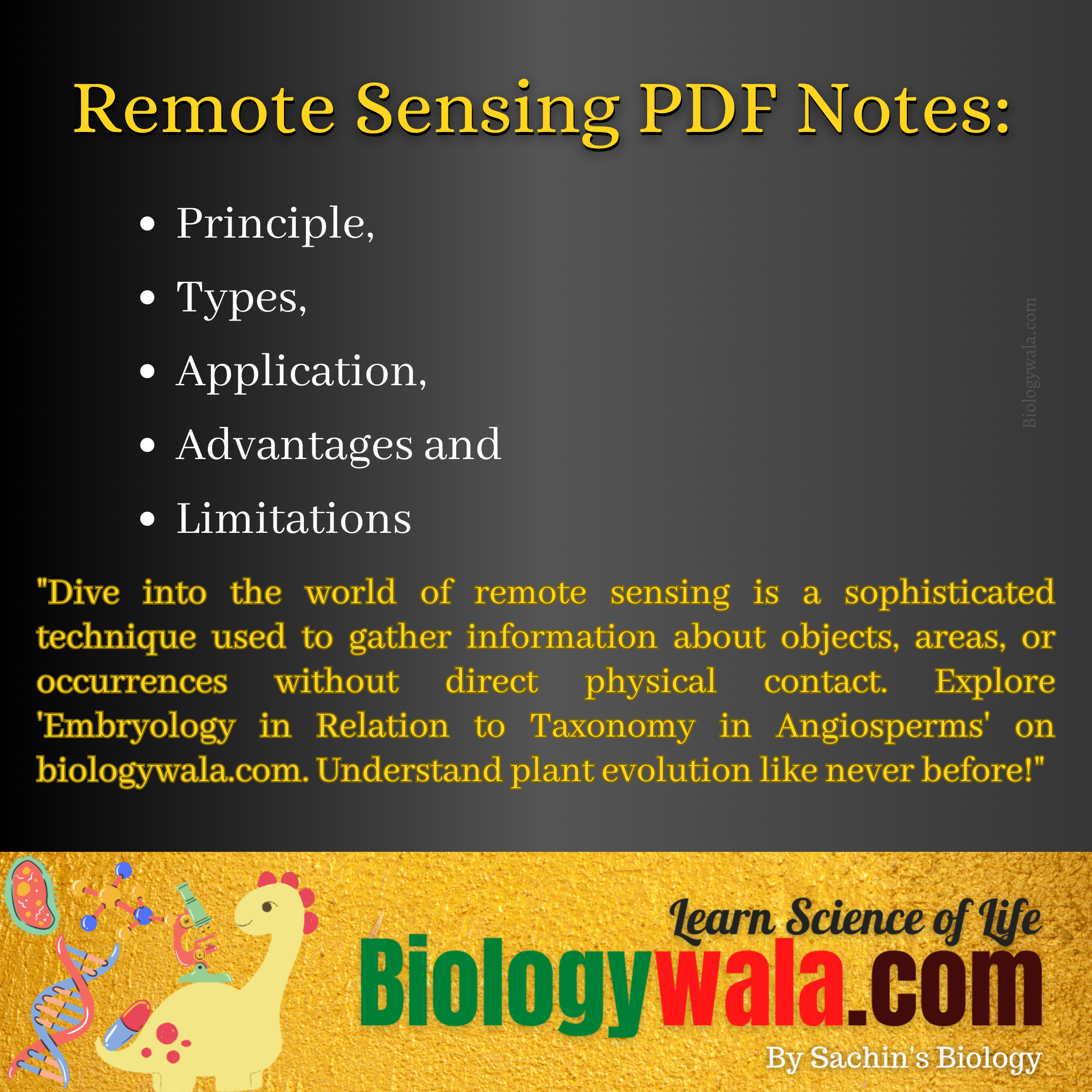Remote Sensing PDF Notes: 2 Types, Application, Principle, Advantages and Limitations

Remote sensing is a sophisticated technique used to gather information about objects, areas, or occurrences without direct physical contact e. This method involves capturing data from a distance, typically utilizing sensors and instruments placed on satellites, aeroplanes, drones, or ground-based platforms. This technology serves as a pivotal tool in diverse fields such as environmental monitoring, agriculture, urban planning, and disaster management.
Principles of Remote Sensing:
How Remote Sensing Works:
Remote sensing is like having special eyes that can see things from far away. It’s all about catching light, which is like messages from objects on Earth. This light can be reflected off things or even sent out by them.
Different Colors of Light:
Just like we see different colours, sensors can “see” different types of light. Some sensors can see red, green, and blue light (like what’s in a rainbow), while others can see light that we can’t see, like heat. These sensors help us know what things are made of and how they’re doing.
Types of Remote Sensing:
1. Passive Remote Sensing:
Passive remote sensing revolves around capturing the inherent energy that objects emit or reflect. A prime example is sunlight being reflected off a lush forest. When sunlight shines upon the forest, the leaves and surfaces reflect some of that light, which we can detect and interpret using sensors. This allows us to gain insights into the composition, health, and other characteristics of the forest without physically touching it. Passive remote sensing is akin to observing how objects interact with the natural energy around them.
2. Active Remote Sensing:
In contrast, active remote sensing takes a more interactive approach. Instead of relying solely on ambient energy, active remote sensing involves emitting energy, like radar or laser beams, towards the target. By doing so, we intentionally “illuminate” the target and measure the energy that bounces back after interacting with the target’s surface. This is analogous to shining a flashlight in a dark room and observing how the light reflects off objects to understand their positions and shapes. For example, radar technology is employed to map the Earth’s surface, revealing intricate details that might be obscured by vegetation or difficult terrain. Active remote sensing lets us actively probe and gather information about objects and areas that might otherwise remain hidden.
By encompassing both passive and active remote sensing, we gain a comprehensive understanding of our surroundings and objects of interest without direct physical contact. These techniques enhance our ability to study everything from forests to urban landscapes and enable us to make informed decisions in various fields.
Components of Remote Sensing:
1. Sensor:
The sensor serves as the attentive eye of remote sensing, diligently collecting data by measuring the electromagnetic radiation emitted or reflected from the target. Just as a camera captures light to create an image, a sensor captures the various wavelengths of electromagnetic radiation to create an informative data set. These sensors can be sensitive to visible light, infrared radiation, microwaves, and more, allowing us to perceive details that might be hidden from the naked eye.
2. Platform:
The platform acts as the support system for the sensor, akin to the stage upon which a performer stands. This carrier can be a satellite orbiting Earth, an aeroplane soaring through the sky, or even a drone navigating specific locations. The choice of platform depends on the scale and scope of the observation. For instance, satellites offer a comprehensive view of large areas, while drones provide a nimble way to inspect localized regions with precision.
3. Data Transmission:
Once the sensor gathers a wealth of data, it’s time to send this treasure trove of information to ground stations for further analysis and interpretation. Think of this step as sharing your discoveries with experts who can unlock the secrets within the data. The collected information is transmitted through various means, including radio signals, to experts who then process and make sense of it. This translation from raw data to meaningful insights is a critical link in the remote sensing process, ensuring that the gathered information is transformed into actionable knowledge.
By understanding these essential components—sensor, platform, and data transmission—we can appreciate how remote sensing technologies function as a well-orchestrated symphony, harmonizing the collection, transportation, and deciphering of data to paint a comprehensive picture of our world from a distance.
Applications of Remote Sensing:
1. Environmental Monitoring:
Remote sensing serves as a powerful tool for keeping a watchful eye on our environment. It’s like having a guardian that tracks changes in landscapes and ecosystems. For instance, when it comes to deforestation, remote sensing helps us observe the gradual disappearance of forests over time. Monitoring pollution levels becomes more effective as sensors detect changes in air and water quality. Moreover, when it comes to climate change, remote sensing enables us to study the impact of temperature shifts on various habitats. In essence, it’s like having a global environmental detective that helps us comprehend the changes our planet undergoes.
2. Agriculture:
Think of remote sensing as a farmer’s best friend, providing insights that foster healthier crops and more abundant harvests. When assessing crop health, remote sensing detects anomalies in the way plants reflect light, giving us early warnings about diseases or nutrient deficiencies. It doesn’t stop there – remote sensing helps predict potential yields by analyzing the size and vigor of crops. When it comes to irrigation, remote sensing aids in deciding the right amount of water to nourish the fields. In essence, it’s like an agricultural advisor that assists farmers in making smart choices for a bountiful harvest.
3. Urban Planning:
Picture remote sensing as the architect’s blueprint for a smarter, more organized city. By analyzing the expansion of urban areas, remote sensing guides city planners in understanding how cities evolve. It delves into traffic patterns, helping design efficient transportation systems. When considering infrastructure, remote sensing identifies areas that need development and areas that should be conserved. In a way, it’s like a city planner’s assistant, helping design livable and sustainable urban spaces.
4. Disaster Management:
Remote sensing stands as the guardian angel during times of calamity. After natural disasters strike, such as earthquakes or floods, remote sensing quickly surveys the affected regions. It maps the extent of damage, identifies areas that need immediate attention, and guides relief efforts to the most critical spots. When it comes to disaster management, remote sensing becomes a beacon of hope, aiding in the efficient deployment of resources and the rapid recovery of communities.
In essence, remote sensing is the all-seeing eye that extends its reach to various domains, providing invaluable insights and empowering us to make informed decisions for a better future.
Remote Sensing Process:
Energy Source and Emission: Imagine the remote sensing process as a conversation between light and the world around it. Here’s how it starts: energy, like sunlight or artificial radiation, is sent forth either from the source itself or reflected off other surfaces. Just like we speak to share information, this energy serves as a language that helps us learn about the objects it interacts with.
Propagation: Think of this energy as a traveller embarking on a journey through space or the atmosphere. It’s like a message in a bottle being carried by waves – these waves of energy travel through the air or the vacuum of space, traversing vast distances to reach their destination.
Interaction with Target: When this energy reaches its destination, it encounters objects and surfaces like a handshake between two friends. The interaction is telling – the energy might be absorbed by the target, like a sponge soaking up water; it could be reflected, bouncing back like a ball thrown against a wall; or it might even pass through, like sunlight through a window. This interaction reveals the target’s characteristics, just as a handshake reveals something about a person’s demeanour.
Recording of Energy: Imagine remote sensing as a diligent observer with keen senses. Sensors, acting as these senses, detect the energy that’s bounced back or emitted from the target. They record these signals, capturing the nuances in wavelengths and intensities. It’s like having a translator that converts the energy’s language into something we can understand – data that holds a treasure trove of information about the object’s composition and properties.
Transmission and Processing: Now, armed with this newfound knowledge, the data embarks on a journey of its own. It travels to ground stations, which are like the laboratories of the remote sensing world. Here, experts work their magic, meticulously analyzing, decoding, and transforming the raw data into meaningful insights. It’s like a puzzle being assembled – each piece of data fits together to create a clear picture of what’s happening on the ground, even from a distance.
In essence, the remote sensing process is a symphony of energy, information, and expertise, working together to unveil the hidden stories of our world and guide decisions that shape our future.
Advantages of Remote Sensing:
1. Wide Coverage: Remote sensing enables swift and efficient surveying of large geographical areas.
2. Access to Inaccessible Areas: It allows for the study of remote or hazardous locations without exposing researchers to unnecessary risks.
3. Temporal Monitoring: By conducting repeated observations, remote sensing facilitates the monitoring of gradual or long-term changes.
Limitations:
1. Weather Conditions: Data collection can be impeded by factors like cloud cover or adverse weather conditions.
2. Limited Spectral Resolution: Not all sensors capture every desired wavelength, limiting the range of data collected.
3. Calibration and Interpretation: Ensuring accurate results requires meticulous calibration of instruments and skilled interpretation of the collected data.
Remote Sensing Platforms:
1. Satellites: These orbit the Earth and collect data from a vantage point in space.
2. Airborne Platforms: Equipped with sensors, aeroplanes allow for detailed and precise observations from the air.
3. Drones (UAVs): Unmanned aerial vehicles offer flexibility and localized data collection capabilities, making them ideal for various applications.
Feel free to integrate these elaborations into your notes, and if you have any further questions, need more details, or want additional examples, please let me know!
Remote sensing is a powerful tool that helps us gather valuable information from a distance, enabling us to make informed decisions across various fields. Its ability to capture data without direct contact has revolutionized the way we study and manage our environment.
Let’s see what recent researchers are publishing about Remote Sensing
Must read For Taxonomy Enthusiasts:
Role of Anatomy in Taxonomy
[Download] A Text Book Of Practical Botany 2 | Bendre Kumar Practical Botany PDF Book
[Download] Plant Systematics by Gurcharan Singh PDF Book 3rd edition
BSI Research Associate Fellowship Programme 2023: A Comprehensive Guide
Join SACHIN’S BIOLOGY on Instagram or Facebook to receive timely updates and important notes about exams directly on your mobile device. Connect with Mr. Sachin Chavan, the founder of Sachin’s Biology and author of biologywala.com, who holds an M.Sc., NET JRF (AIR 21), and GATE qualifications. With SACHIN’S BIOLOGY, you can have a direct conversation with a knowledgeable and experienced.


![[Download] Free Molecular Biology of Cancer PDF Book 4th Edi. 4 [Download] Molecular Biology of Cancer PDF BOOK by Lauren Pecorino](https://biologywala.com/wp-content/uploads/2022/02/Molecular-Biology-of-Cancer-PDF-Book-4th-Edition-520x245.jpg)